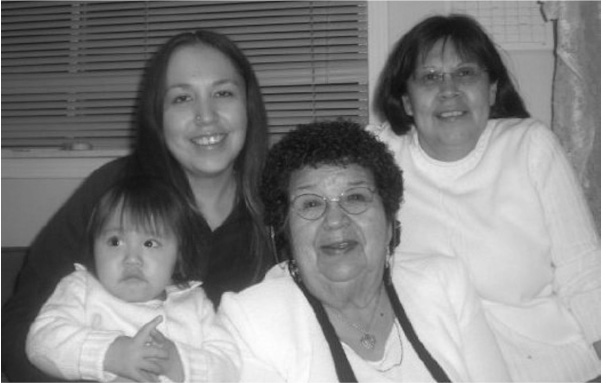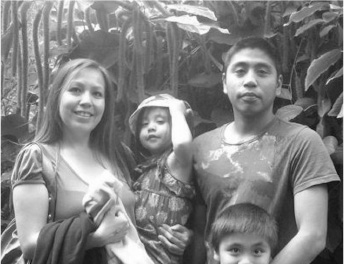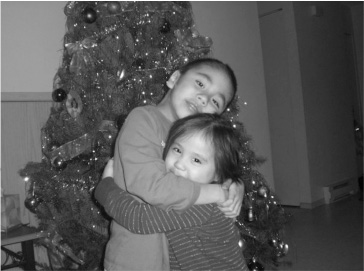
Klahoose Traditional Territory.20
by Jennifer Harry
My name is Jennifer Harry, I am of northern Coast Salish decent, from a Nation called Klahoose.

Klahoose Traditional Territory.20
Sadly, big chunks of traditional culture have been lost due to the bans imposed on the First Nations people of Canada by the government. Still, some of the traditional practices are still around. Many of these practices have been shared with me by my grandmother . . . this is what she told me:
Traditionally, when women went into labor, they were to go to a safe spot alone, away from the village, to give birth. This shows the great strength of my ancestors—to be able to go out alone and give birth to your child is amazing. When I went into labor it was so terrifying. I admire the strength that my people hold.

Four generations of women: Jennifer with her
daughter, mother, and grandmother.
My grandmother has also told me that while pregnant, it is bad luck to attend funeral ceremonies or to go into cemeteries. It is also bad luck to let young children roam in a cemetery without an adult. At all times, if a child is in the cemetery, you are to hold their hands and to never let go.
I am a mother of two. I have one son who is seven, and a daughter who is four. My children’s heritage is half Coast Salish and half Filipino. For both of my children, I used a midwife instead of a doctor. The birth of my son was a challenge. I managed to get through it naturally without any, so to speak, medical aids like laughing gas. The night before he was born, I began to feel uncomfortable and felt what I believe were mild contractions here and there. This was two weeks before his due date. Nothing happened all night except a lack of sleep for me. My midwife came to check on me the following day and said it could be up to a week before I went into labor. A few hours later around 5 p.m. I began to feel strong contractions. My boyfriend called my midwife. Contractions grew stronger every hour. We all remained as calm as possible, breathed, and used the exercise ball to help move things along more quickly. By 1:05 a.m. my son was born. My boyfriend, mother, and midwife talked me through the whole thing and were all very supportive. I was elated and excited to finally meet him. He was very beautiful!
My daughter, on the other hand, was born prematurely by about six weeks. I was visiting family in my small hometown community, to celebrate my grandpa’s birthday. I woke up at around 5:30 a.m. to use the bathroom and, as I entered the bathroom, my water broke. I wondered, What just happened?, as with my first child my water didn’t break. My mom was concerned that I was so early and called an ambulance. They flew me by helicopter to Campbell River General Hospital, as there wasn’t a hospital in my hometown. The hospital was not equipped to deliver and care for a premature baby, so from there they flew us to Victoria General Hospital.
I had no contractions all day. Once examined by the doctor, there was no choice but to induce labor, if I didn’t go into labor naturally by the next morning. I thankfully had my boyfriend with me for support. At around 2:30 in the morning I began to feel mild contractions. An hour later, I had moved into active labor. This labor for me was way more intense and painful, and quicker. I had hoped to do it, once again, naturally—but once I got to try laughing gas, it made me feel so much better that I couldn’t let go of the mask, I am embarrassed to say. I again used the exercise ball to help things move along more quickly.
My daughter came very quickly and was so very tiny that I barely had to push. She was born at around 8 a.m. and was delivered by her father in the hospital without a doctor in the room. We did have the midwife in the room with us. To say the least, the hospital staff was not pleased. And we were all a bit scared, as with her being premature, there could have been further complications. My daughter went into an incubator only for a couple hours—she was breathing fine on her own and was healthy. They advised us that she would have to be in the hospital for at least two weeks as she could not eat on her own. We stayed in the Victoria General Hospital for four or five days and then were able to move to the hospital in Comox. I was not happy with the move, as the staff was not as well trained as the nurses in the premature unit in Victoria. I wish we had stayed in Victoria longer. Thankfully, I was able to convince the doctor in Comox to release her early as she was feeding on her own and I could look after her better than the hospital could.

The whole family.
Both my daughter and son are now grown, happy children, full of laughter and smiles. They bring joy and pride to our lives every day. We are grateful to have healthy children without any health complications, especially since our daughter was premature.
I recently finished up my Bachelor of Education degree in Elementary Education at the University of Victoria. I have recently become more interested and passionate about learning more about my culture and language as an adult. I hope to get the chance to move closer to home to do so, as well as to expose my children more to their native language, so that they gain a better understanding of who we are and where we come from. I want them to know their Coast Salish and Filipino heritage and to learn to value the importance of where you come from. Unfortunately, our Indigenous language is slowly fading and it is like a race against time to save it. I want to dedicate a greater part of my time to learning and documenting our language, and to creating resources for schools and the community. Without our language, we lose our culture and heritage. I don’t want to see this happen and this why I want to do what I can to help save it for my children and for future generations.

Celebrating!
Jennifer lives with her family in Campbell River, where she is a teacher. She holds a degree in Elementary Education, a First Nations Language Certificate, a Certificate in Aboriginal Language Revitalization, and a Certificate in Early Childhood Education and Care.